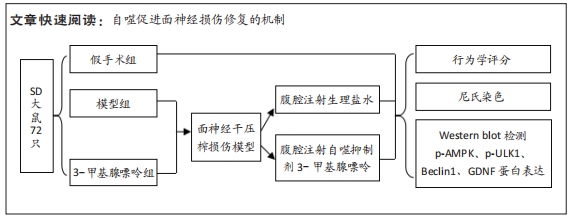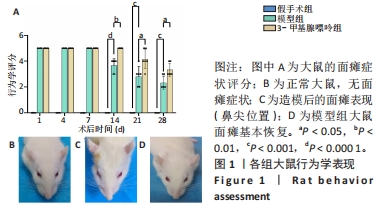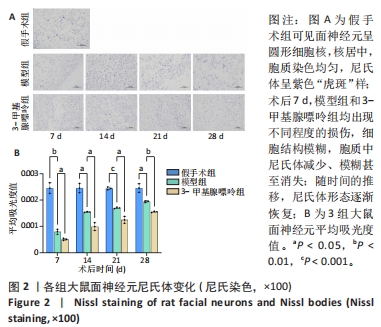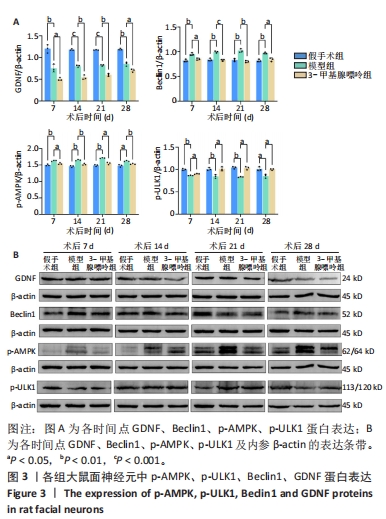[1] TOULGOAT F, SARRAZIN JL, BENOUDIBA F, et al. Facial nerve: from anatomy to pathology. Diagn Interv Imaging. 2013;94(10):1033-1042.
[2] SPENCER CR, IRVING RM. Causes and management of facial nerve palsy. Br J Hosp Med (Lond). 2016;77(12):686-691.
[3] FEI J, GAO L, LI HH, et al. Electroacupuncture promotes peripheral nerve regeneration after facial nerve crush injury and upregulates the expression of glial cell-derived neurotrophic factor. Neural Regen Res. 2019;14(4):673-682.
[4] RIVERA A, RAYMOND M, GROBMAN A, et al. The effect of n-acetyl-cysteine on recovery of the facial nerve after crush injury. Laryngoscope Investig Otolaryngol. 2017;2(3):109-112.
[5] 杨万章,吴芳,张敏.周围性面神经麻痹的中西医结合评定及疗效标准(草案)[J].中西医结合心脑血管病杂志,2005,3(9):786-787.
[6] 唐杰,戚孟春,胡静.胶质细胞源性神经营养因子在自体静脉桥修复面神经缺损中促进神经再生的效应[J].华西口腔医学杂志,2011,29(1):87-91.
[7] TAJDARAN K, GORDON T, WOOD MD, et al. A glial cell line-derived neurotrophic factor delivery system enhances nerve regeneration across acellular nerve allografts. Acta Biomater. 2016;29:62-70.
[8] HENDERSON CE, PHILLIPS HS, POLLOCK RA, et al. GDNF: a potent survival factor for motoneurons present in peripheral nerve and muscle. Science. 1994;266(5187):1062-1064.
[9] TRUPP M, RYDÉN M, JÖRNVALL H, et al. Peripheral expression and biological activities of GDNF, a new neurotrophic factor for avian and mammalian peripheral neurons. J Cell Biol. 1995;130(1):137-148.
[10] LI L, WU W, LIN LF, et al. Rescue of adult mouse motoneurons from injury-induced cell death by glial cell line-derived neurotrophic factor. Proc Natl Acad Sci U S A. 1995;92(21):9771-9775.
[11] EGGERS R, DE WINTER F, SMIT L, et al. Combining timed GDNF and ChABC gene therapy to promote long-distance regeneration following ventral root avulsion and repair. FASEB J. 2020;34(8):10605-10622.
[12] IBÁÑEZ CF, ANDRESSOO JO. Biology of GDNF and its receptors - Relevance for disorders of the central nervous system. Neurobiol Dis. 2017;97(Pt B):80-89.
[13] SHI Z, LI CY, ZHAO S, et al. A systems biology analysis of autophagy in cancer therapy. Cancer Lett. 2013;337(2):149-160.
[14] CHANG JT, HANSEN M. Age-associated and tissue-specific decline in autophagic activity in the nematode C. elegans. Autophagy. 2018;14(7):1276-1277.
[15] BHUKEL A, BEUSCHEL CB, MAGLIONE M, et al. Autophagy within the mushroom body protects from synapse aging in a non-cell autonomous manner. Nat Commun. 2019;10(1):1318.
[16] DAMME M, SUNTIO T, SAFTIG P, et al. Autophagy in neuronal cells: general principles and physiological and pathological functions. Acta Neuropathol. 2015;129(3):337-362.
[17] DIKIC I, ELAZAR Z. Mechanism and medical implications of mammalian autophagy. Nat Rev Mol Cell Biol. 2018;19(6):349-364.
[18] THORBURN A. Apoptosis and autophagy: regulatory connections between two supposedly different processes. Apoptosis. 2008;13(1):1-9.
[19] BUTLER DE, MARLEIN C, WALKER HF, et al. Inhibition of the PI3K/AKT/mTOR pathway activates autophagy and compensatory Ras/Raf/MEK/ERK signalling in prostate cancer. Oncotarget. 2017;8(34):56698-56713.
[20] PELICCI G, TROGLIO F, BODINI A, et al. The neuron-specific Rai (ShcC) adaptor protein inhibits apoptosis by coupling Ret to the phosphatidylinositol 3-kinase/Akt signaling pathway. Mol Cell Biol. 2002;22(20):7351-7363.
[21] ZHANG Y, MIAO JM. Ginkgolide K promotes astrocyte proliferation and migration after oxygen-glucose deprivation via inducing protective autophagy through the AMPK/mTOR/ULK1 signaling pathway. Eur J Pharmacol. 2018;832:96-103.
[22] 郑红弟.面神经压榨损伤后面神经功能及形态学恢复的研究[D].泸州:西南医科大学,2022.
[23] CHEN L, MO S, HUA Y. Compressive force-induced autophagy in periodontal ligament cells downregulates osteoclastogenesis during tooth movement. J Periodontol. 2019;90(10):1170-1181.
[24] 杨敏,唐寅达,应婷婷,等.SD大鼠面神经干局部脱髓鞘模型制作[J].中国微侵袭神经外科杂志,2016,21(3):131-134.
[25] DE FARIA SD, TESTA JR, BORIN A, et al. Standardization of techniques used in facial nerve section and facial movement evaluation in rats. Braz J Otorhinolaryngol. 2006;72(3):341-347.
[26] LOPES B, SOUSA P, ALVITES R, et al. Peripheral Nerve Injury Treatments and Advances: One Health Perspective. Int J Mol Sci. 2022;23(2):918.
[27] HÖKE A. Mechanisms of Disease: what factors limit the success of peripheral nerve regeneration in humans? Nat Clin Pract Neurol. 2006;2(8):448-454.
[28] GORDON T, TYREMAN N, RAJI MA. The basis for diminished functional recovery after delayed peripheral nerve repair. J Neurosci. 2011;31(14):5325-5334.
[29] HEINE W, CONANT K, GRIFFIN JW, et al. Transplanted neural stem cells promote axonal regeneration through chronically denervated peripheral nerves. Exp Neurol. 2004;189(2):231-240.
[30] SULAIMAN OA, GORDON T. Effects of short- and long-term Schwann cell denervation on peripheral nerve regeneration, myelination, and size. Glia. 2000;32(3):234-246.
[31] SHI R, WENG J, ZHAO L, et al. Excessive autophagy contributes to neuron death in cerebral ischemia. CNS Neurosci Ther. 2012;18(3):250-260.
[32] ZHANG Y, ZHANG LH, CHEN X , et al. Piceatannol attenuates behavioral disorder and neurological deficits in aging mice via activating the Nrf2 pathway. Food Funct. 2018;9(1):371-378.
[33] 费静,陶美惠,李雷激.电针干预面神经压榨模型大鼠促进面神经的再生[J].中国组织工程研究,2022,26(11):1728-1733.
[34] 肖阳,龚立琼,费静,等.电针干预面神经损伤模型兔面神经核团中神经生长因子及其受体的表达[J].中国组织工程研究,2022,26(8):1253-1259.
[35] 费静,郑红弟,余莉亚,等.胶质细胞源性神经营养因子/PI3K/AKT通路参与电针促进面神经压榨损伤模型兔的面神经再生[J].中国组织工程研究,2020,24(7):1094-1100.
[36] MIZUSHIMA N, LEVINE B, CUERVO AM, et al. Autophagy fights disease through cellular self-digestion. Nature. 2008;451(7182):1069-1075.
[37] JANG SY, SHIN YK, PARK SY, et al. Autophagy is involved in the reduction of myelinating Schwann cell cytoplasm during myelin maturation of the peripheral nerve. PLoS One. 2015; 10(1):e0116624.
[38] SEGLEN PO, GORDON PB. 3-Methyladenine: specific inhibitor of autophagic/lysosomal protein degradation in isolated rat hepatocytes. Proc Natl Acad Sci U S A. 1982;79(6):1889-1892.
[39] MARINELLI S, NAZIO F, TINARI A, et al. Schwann cell autophagy counteracts the onset and chronification of neuropathic pain. Pain. 2014;155(1):93-107.
[40] CHEN H, HU Y, XIE K, et al. Effect of autophagy on allodynia, hyperalgesia and astrocyte activation in a rat model of neuropathic pain. Int J Mol Med. 2018;42(4):2009-2019.
[41] ZHAO Y, FENG X, LI B, et al. Dexmedetomidine Protects Against Lipopolysaccharide-Induced Acute Kidney Injury by Enhancing Autophagy Through Inhibition of the PI3K/AKT/mTOR Pathway. Front Pharmacol. 2020;11:128.
[42] ZHANG YL, YAO YT, FANG NX, et al. Restoration of autophagic flux in myocardial tissues is required for cardioprotection of sevoflurane postconditioning in rats. Acta Pharmacol Sin. 2014;35(6):758-769.
[43] LIN LF, DOHERTY DH, LILE JD, et al. GDNF: a glial cell line-derived neurotrophic factor for midbrain dopaminergic neurons. Science. 1993;260(5111):1130-1132.
[44] OMURA T, SANO M, OMURA K, et al. Different expressions of BDNF, NT3, and NT4 in muscle and nerve after various types of peripheral nerve injuries. J Peripher Nerv Syst. 2005;10(3):293-300.
[45] CHEN P, PIAO X, BONALDO P. Role of macrophages in Wallerian degeneration and axonal regeneration after peripheral nerve injury. Acta Neuropathol. 2015;130(5):605-618.
[46] MASAKI T, MATSUMURA K, SAITO F, et al. Expression of dystroglycan and laminin-2 in peripheral nerve under axonal degeneration and regeneration. Acta Neuropathol. 2000;99(3):289-295.
[47] IWASE T, JUNG CG, BAE H, et al. Glial cell line-derived neurotrophic factor-induced signaling in Schwann cells. J Neurochem. 2005;94(6):1488-1499.
[48] CAO Q, DU H, FU X, et al. Artemisinin Attenuated Atherosclerosis in High-Fat Diet-Fed ApoE-/-
Mice by Promoting Macrophage Autophagy Through the AMPK/mTOR/ULK1 Pathway. J Cardiovasc Pharmacol. 2020;75(4):321-332.
[49] CAI ZY, YANG B, SHI YX, et al. High glucose downregulates the effects of autophagy on osteoclastogenesis via the AMPK/mTOR/ULK1 pathway. Biochem Biophys Res Commun. 2018;503(2):428-435.
[50] SHANG L, WANG X. AMPK and mTOR coordinate the regulation of Ulk1 and mammalian autophagy initiation. Autophagy. 2011;7(8):924-926.
[51] KIM J, KUNDU M, VIOLLET B, et al. AMPK and mTOR regulate autophagy through direct phosphorylation of Ulk1. Nat Cell Biol. 2011;13(2):132-141.
[52] HA J, GUAN KL, KIM J. AMPK and autophagy in glucose/glycogen metabolism. Mol Aspects Med. 2015;46:46-62.
[53] HWANG JY, GERTNER M, PONTARELLI F, et al. Global ischemia induces lysosomal-mediated degradation of mTOR and activation of autophagy in hippocampal neurons destined to die. Cell Death Differ. 2017;24(2):317-329.
|




